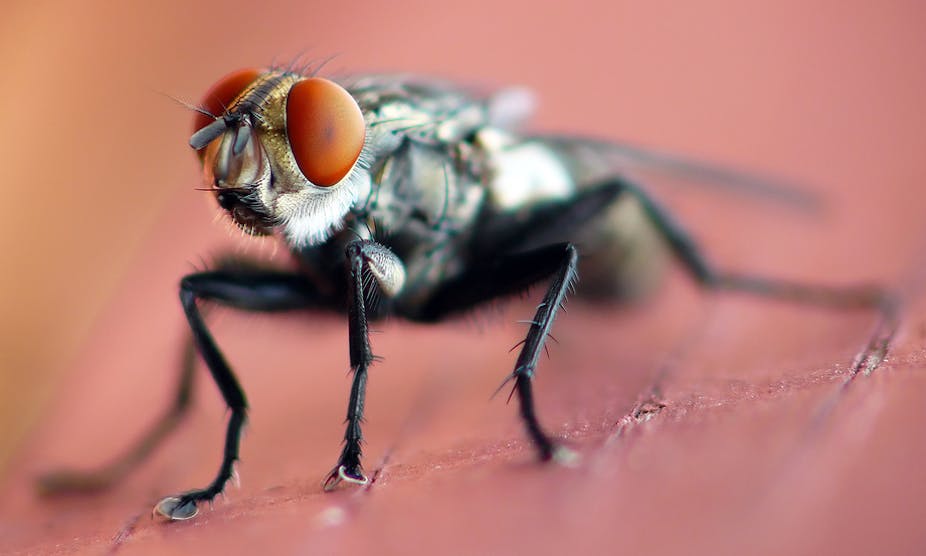FORENSICS AUSTRALIA – Insects are everywhere. Their ubiquitous nature, and the fact they represent the largest biomass of animals on the earth, means there are hardly any terrestrial niches – except when an animal is buried, immersed in water or frozen – that have not been exploited by this group.
The main protagonist in insect attacks on cadavers is flies – two-winged insects and beetles. Most people experience flies – generally house flies and bush flies – while they are alive and consider them pests.
The flies that people see less of are blowflies, which tend to maintain a distance from animals until such animals are dead, comatose, unconscious or, in the case of some humans, heavily intoxicated.
There are some exceptions such as the sheep blowfly and other myiasis flies that will strike a live animal.
Blowflies, depending on the species, either lay eggs or live larvae onto a corpse. This generally happens within an hour of the animal becoming immobile.
Blowflies are attracted to orifices, wounds and other moist locations such as between the fingers or toes, the armpits or any observable body crease.
When attending a crime scene it’s from these moist locations that insect material is sampled.
The insect material is then identified, sometimes based on the size of the immatures (maggots). The size of these immatures is a reflection of estimated age – the most important parameter by which minimum time of death can be estimated.
The person who does this work is a forensic entomologist. The term “forensic entomology” is generally used to describe the study of insects and other arthropods associated with certain suspected criminal events.
These typically include homicides, suspicious deaths, sudden deaths and suicides.
I have been involved with every aspect of forensic entomology for the past 23 years and am the only accredited forensic entomologist in Australia.
For ten years, I have also been part of the teaching faculty of the FBI’s Investigation Human Remains Recovery School, teaching Evidence Response Teams for the last 10 years in the USA.
For me this has meant attending more than 200 homicides in Western Australia, Queensland, New South Wales and the Northern Territory, as well as reviewing cases in North America and Northern Ireland.
Of course, these numbers are low as Australia boasts one of the lowest homicide rates in the world (approximately one in every 100,000 people every year) and only 15-20% of these have any associated insect material present.
Estimating the minimum time of death sits within the broader discipline of medico-legal entomology which includes:
- determining the location of where a human death occurred
- cases involving toxins, drugs and gunshot residues
- the movement of vehicles and transport of remains
- injuries after death
- insect bites or infestations
- neglect of the elderly
- child abuse
- food contamination by insects
- veterinary and wildlife forensics.
Modern twists
One traditional technique forensic entomologists have turned into a modern day treatment is maggot therapy. When antibiotics fail, many limbs have been saved by administering sterile maggots into gangrenous or necrotic wounds.
There are two other major areas where forensic entomology plays a role.
The first is urban entomology, which involves civil actions relating to insects and human-built structures, as may occur with termites and buildings.
This is becoming even more commonplace with the reduction into the environment of dangerous insecticides and no real protective barriers to insect attack.
The second is stored product entomology, which involves civil actions related to insect infestations of commodities such as food.

Have you ever unwrapped a muesli bar, opened a bag of fruit and nuts or checked a bag of flour on the shelf and found insects or webbing inside?
This is insect damage, which you can solve yourself by freezing such products for up to ten days following purchase to kill any insect material.
Time flies
The bread-and-butter reasons for forensic entomology involve ageing insects to determine a post-mortem interval (PMI).
With respect to time taken for carrion-eating insects to arrive on a body, there are many environmental and species-specific factors that will determine whether insects are common in the area of an unattended corpse.
In contrast, other types of insects will not be attracted by a corpse until it is in one of the later stages of decay.
So, the presence of an insect known to be attracted only by a dry, decayed corpse indicates that the corpse has been dead for some time and has already passed through fresh, bloat and wet decay stages.
And of course this is all dependent on weather factors, the most important being temperature and rainfall.
Insects (other than blowflies) that feed on decaying flesh include beetles, wasps and moths, and, by the time the last species arrives, the earliest arrivals are generally no longer present.
This is but a snapshot of what a forensic entomologist is expected to have expertise in, because as a result of any investigation involving insects, a “FE” will probably end up in a court of law to provide an opinion.
In essence, contemporary forensic entomology is a crucial tool in providing a chronological “gold standard” in the evaluation of postmortem intervals when insects are associated with a corpse.
This is part three of The Conversation’s Forensics Australia series. Read part one and part two.

